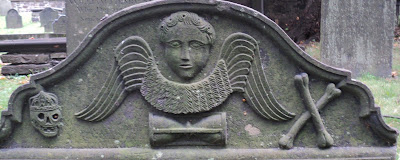Located on Barrington Street in downtown Halifax, The Old Burying Ground stands as a testimony to Halifax's early days. Founded in 1749, the same year as the settlement, it was Halifax's first and only burying ground.
The entrance is dominated by a rare pre-Confederation memorial to the 1853 – 1856 Crimean War.
As well as headstones there are footstones, and tablestones in this cemetary. Footstones are smaller than headstones and may be very brief while tablestones were created for more important folk and could include larger inscriptions.
The Burying Ground was closed to new burials in 1844. Fenced and landscaped in the 1860s, it was restored as a park and outdoor museum in 1990-1991. Over 12,000 souls are buried here, even though only about 1,200 markers remain.
Two famous people buried here are Captain Lawerence of the USS Chesapeake who is more famous in the US for his "Don't give up the ship" cry, uttered just before he gave up his ship. And a British general who was responsible for burning down Washington DC during the War of 1812.
A plaque near the entrance explains:
"The Old Burying Ground constitutes a unique concentration of gravestone art. A rich variety of styles, poignant images and carving skills is reflected in these old stones. The winged skulls and the winged heads, or soul effigies, are exceptional."
The images or symbols can be a clue to age. Older stones show symbols of death -- stylized winged skulls ("death-heads") or winged angels (soul effigies).
In the early 1800's the images gradually changed from representations of death to those of bereavement -- funerary urns, lamps (of life, extinguished), and sometimes springs of willow (weeping).
Though the explanation I found referred to the extinguished lamps (of life), I kept finding images that clearly showed a flame still coming from the lamp as the above images show.
Crossed bones represent death while the skull with the crown, resurrection, while an hourglass represents time.
This large tablestone once had carvings on its four enclosed sides, but only two remain. The fascinating image below is from one end of the monument.
I think it's depicting the resurected person (wearing the crown) rising from his grave to the trumpeting of an angel. And of course, there's an hourglass ...
Wandering among the headstone the lead in from a TV soap opera kept looping through my mind:
"Like the sands through an hourglass, so are the Days of Our Lives".










Thank you for this tour. I moved to NS two years ago and have been meaning to stop by here. There is something about old cemetaries that calms my soul.
ReplyDeleteSo Sara, did you every visit the Old Burying Ground ?
DeleteThanks Sara. I am fascinated by cemetaries too.
ReplyDeleteSybil
Thank you for this link, Sybil!
ReplyDeleteWhat a beautiful cemetery, so full of history. The memorial to the Crimean War gave me pause because Crimea is so much on the news recently. So much history to ponder - my dad was the son of Ukrainian immigrants, so this war also affected his ancestors. I learn a little more each time I visit a cemetery.
The art on the stones is well preserved and fascinating, too.